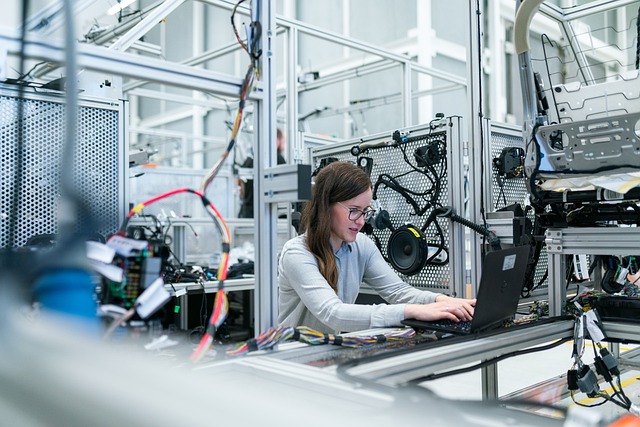- July 29, 2020
- Posted by: David Marshall
- Category: Digital Transformation, Manufacturing

Digital media has done a lot for the sales and marketing world. We can quickly and easily create photos and videos, personalize them for people, and even automate that process. Software has done some amazing things to not only allow marketers to reach their customers but to create amazing content to reach them with.
The manufacturing world has experienced a lot of these same disruptions and innovations thanks to digital manufacturing. This new technology has turned what was an unchanging and slow-moving practice into an agile, quick-to-change method of production in what experts are calling Manufacturing 4.0.
The phrase refers to the digital aspect of manufacturing, which is enabled not only by computerized hardware, but the software needed to operate these machines.
 I recently read an article on the Institution of Mechanical Engineers website, Digital Manufacturing Helps Companies Thrive in an On-Demand World, that discussed how “innovators are seeking new ways to reshape the (manufacturing) industry.”
I recently read an article on the Institution of Mechanical Engineers website, Digital Manufacturing Helps Companies Thrive in an On-Demand World, that discussed how “innovators are seeking new ways to reshape the (manufacturing) industry.”
Having helped oversee a digital revamping of an entire manufacturing plant, I’ve seen first-hand how companies can innovate and adopt new manufacturing methods, and I think now is the time to start looking at how they can do it themselves.
(Note: I don’t think manufacturers need to leap into a digital overhaul at this time, because it’s too early to tell how long this economic downturn and pandemic will last. But they need to start lining up their research and making some initial plans.)
The Five Improvements Digital Manufacturing Can Make
First, like it or not, digital manufacturing can mean reducing your general labor force. Digital manufacturing machines are able to produce more parts with less human operation. That will keep people safe from possible infection.
Second, digital manufacturing will lead to more high-paying, often six-figure salary, jobs. If you can provide training and education for your current workforce, you’ll still be able to benefit from the institutional knowledge these experienced people bring to the position.
Third, digital manufacturing can also create more mass customization for customers. For example, depending on your products, you can more easily produce components or devices to a customer’s specs, whether it’s through a CNC machine, 3D printing, or with specialty machines that are able to select forming components on the fly.
For example, 3D printing has opened up all kinds of possibilities, whether it’s individual parts for an oil derrick one day and rarely-ordered furniture items another. 3D printing is the ultimate in manufacturing customization and while it still cannot be used to mass-produce items, it has gone a long way to helping companies reduce their manufacturing and inventory costs of their rarely-sold catalog items.
Fourth, digital manufacturing can also help deal with shortened product life cycles, even as they can speed up new product introductions. Björn Klaas, author of the IMECHE article, said:
These two are intrinsically tied together. With near-instant access to market feedback, design and engineering teams can respond to what the market is telling them. More so, they can have physical products of design iterations in their hands in a few days, and subsequently reintroduce product updates to the market quickly. And it’s not just small modifications to existing products, it’s entirely new products being developed. Iteration leads to innovation, and an on-demand supply chain supports that.
Finally, says Klaas, digital manufacturing can create a more responsive supply chain. Rather than overproducing a particular item only to find out your customer base doesn’t want it, leaving you stuck with the warehousing and manufacturing costs, you can turn to a more flexible manufacturing plan that lets you produce only what you need when you need it.
This high-mix, low-volume approach lets you quickly pivot to meet market demands. You build what customers need until they don’t need anymore. When they want something else, you give them what they want. Then you have a virtual inventory, rather than an actual inventory of parts you’re still holding onto two years later.
Last week, I said companies should wait until we’re a little more sure about the economy and our recovery before just blindly rushing ahead and upgrading to a more digital-first operation. But that doesn’t mean waiting until it’s already started before you even consider it.
Now is a good time to start planning and plotting and exploring your different options. Pay attention to your industry news journals and see who’s announcing their new upgrades and changes. They may be the canary in the coal mine. Take a look at what they’re doing and see if it’s something you could easily manage.
Start talking with digital manufacturing experts about your options and see what kinds of changes you could make, what impact will they have on your company, and get a sense of the timeline of actually pulling the trigger on that kind of change.
I’ve been a manufacturing executive, as well as a sales and marketing professional, for a few decades. Now I help companies turn around their own business, including pivoting within their industry. If you would like more information, please visit my website and connect with me on Twitter, Facebook, or LinkedIn.
Photo credit: RAEng_Publications (Pixabay, Creative Commons 0)

